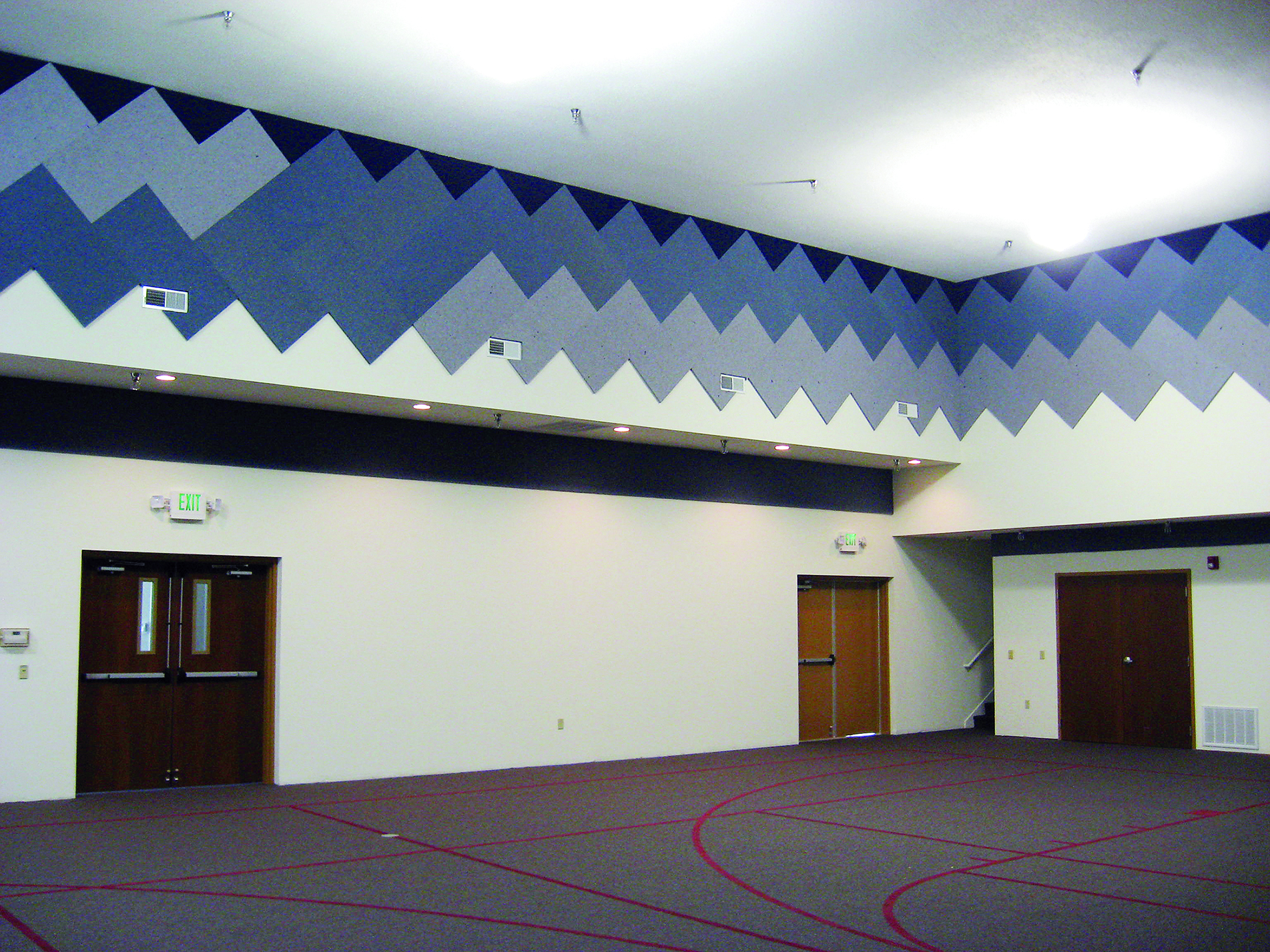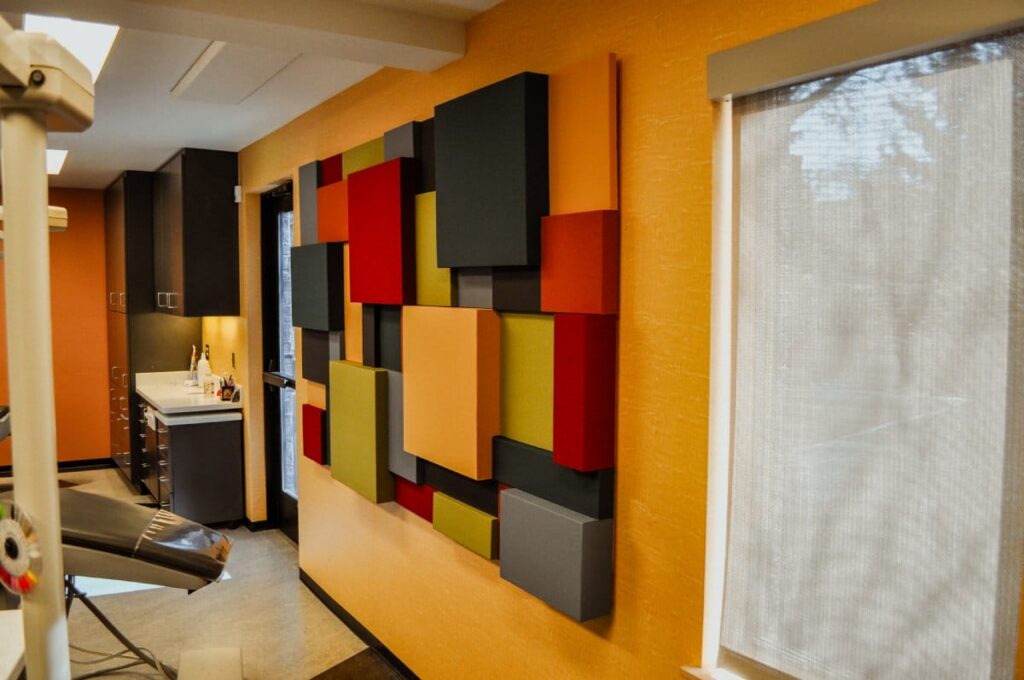What’s The Difference When Comparing Fiberglass Panels vs Acoustic Foam?
When it comes to building or designing a new space, sound treatment is sometimes one of the last things on an architect or engineer’s mind. But, in many cases, it shouldn’t be. Although the initial price of acoustic foam panels or fiberglass acoustic wall panels may seem like an afterthought, poor acoustics can damage user experience and even cause expensive fines for non-compliance with fire codes and safety regulations if the right options are not used. The good news is that incorporating acoustic paneling in the design phase of a space is one of the best ways to seamlessly improve sound, create more visually appealing architecture, and stay safe on multiple levels. But when comparing acoustic foam vs fiberglass panels, it’s important to make the right choices and work with the right suppliers to get optimal performance.
In this article, we’ll share seven reasons why fiberglass is clearly the better choice but the take home message is this: If you’re looking for lasting, high-performance acoustic treatment materials that are safe and beautiful, fiberglass panels are the clear winner every time.
1. Sound Absorption Performance: Foam vs. Fiberglass
In the acoustic foam vs fiberglass panel debate, there’s no question that sound absorption is important. But when people ask us to provide soundproofing advice for a studio, workspace, or commercial space, there are some basic principles we always follow.
We get it – foam can appear to be the less expensive option in any acoustic foam vs fiberglass panels comparison, but you get what you pay for with soundproofing materials. Acoustic foam (pyramid, wedge, or even egg crate foam) has a role to play, especially if you’re into DIY acoustic foam panels for home studio users. But these materials are typically very low in low-frequency absorption and have limited performance at best. That’s not to say you won’t find improvements with foam – the point is that they are significantly better in the upper frequency ranges.
The other option is to invest in high quality materials and consider safety and performance on every level. So, in the acoustic foam vs fiberglass panels debate, fiberglass acoustic panels (Acoustic Geometry’s fabric-wrapped fiberglass acoustic panels, in particular), like the dense fiberglass products by Owens Corning 703/705, are a great fit and also perform well in the low end. If you’re looking to round out your acoustic treatment approach and have more balanced acoustic results over the entire frequency spectrum, fiberglass acoustic wall panels are the way to go.
To find out which will provide the best performance (0.4 to 0.8 for acoustic foam and as high as 0.9+ for fiberglass), check the NRC rating for acoustic panels. By using fiberglass panels, you can achieve the same, if not better, results with fewer units.
If sound absorption effectiveness is your priority, fiberglass panels easily outperform foam across a broader frequency range with a higher NRC rating.
Interested in more technical details? Check out Acoustic Geometry’s high-performance absorbers.
2. Safety and Fire Ratings: Don’t Get Burned by Foam
One thing that many architects, contractors, interior designers, and installers forget is safety. Polyurethane foam is the biggest offender in this department, especially with many online or knock-off brands that sell cheap, Class C or B soundproofing foam.
In fact, many of these cheap “soundproofing” foam products haven’t even been tested by an independent lab or product certification agency for fire resistance. This makes them completely unsafe and non-compliant with basic building codes.
While Melamine foam is a safe foam option (there are actually legitimate, safe foam options), we all know polyurethane foam (as used in most products sold today) is a fire hazard, not to mention that its performance is so-so. By sticking to fiberglass acoustic wall panels and other options made in the U.S.A. and tested for fire-resistance by independent labs, you ensure a safe space for users and protect yourself from liability and compliance issues.
All of our products at Acoustic Geometry are Class A rated (ASTM E84/UL 723 compliant).
Choosing safe acoustic treatment solutions like fiberglass, cotton or PET based panels ensures your space is not only acoustically optimized but also fire-compliant and non-toxic. Always pay close attention to acoustic panel fire ratings. Only products like our Class A fiberglass panels meet the rigorous safety standards required for commercial and public spaces.
So, if we were to chime in on the acoustic foam vs fiberglass panels debate, we would rarely suggest using foam based panels. There are other sound panel material options that are safe and sustainable (Cotton, PET felt, CFAB, etc.). We cover those in section #7 below.
3. Installation Methods and Wall Damage
Did you know that a major difference in our fiberglass coew acoustic panels versus other options is how they are installed, the versatility of their installation, and any resulting wall damage? Foam acoustic panels are most often glued to the wall with spray adhesive and construction adhesive, which results in significant paint damage when you need to remove the panels. In addition, once installed, they are typically not reusable.
Fiberglass panels, however, can be installed in a number of ways using impaling clips which generally also requires the use of adhesive, but Z-bars or a system like RotoFast Snap-On anchors – neither of these options requires adhesive at all and are both completely clean and renter-friendly. Glue-based installation leads to serious wall damage from foam panels, whereas fiberglass options allow for clean removal and renter-friendly mounting solutions.
Want an even sleeker look? Explore Acoustic Geometry’s Wallmate Stretch Wall System for fabric integration that leaves essentially zero wall damage.
4. Cost vs. Value: Which Offers Long-Term ROI?
In a strict cost comparison for a specific set of acoustic panels, foam may win. However, when you consider the NRC, you quickly see that fiberglass acoustic panels actually provide higher value overall. Using fewer panels generally leads to lower total installation costs.
Foam panels, due to lower performance (NRC), need to be used more often and in greater coverage. Additionally, the durability of foam panels is lower, meaning they can degrade, turn yellow, and crack, resulting in more replacements over time.
Fiberglass acoustic panels require a higher initial investment, but over time you’ll need fewer of them, and they will last. Need help seeing the differences? Check out Acoustic Geometry’s wide variety of Class A acoustic panels to evaluate the options yourself. When comparing your options, the fiberglass acoustic panel benefits stand out clearly, from superior low-frequency absorption to long-term durability and design flexibility.
5. Durability and Longevity: Foam Crumbles, Fiberglass Lasts
Has anyone ever asked for your help removing old acoustic foam? Once installed, foam is nearly impossible to remove and reuse. Foam panels turn brittle, yellow, and crumbly over time. Plus, they are dusty, saggy, and more difficult to keep clean.
Fabric-wrapped fiberglass acoustic panels, on the other hand, maintain shape and structure for much longer, as in multiple years. Additionally, some fabric options are bleach cleanable or have high washability when appropriate, meaning they are designed for a virtually “forever” installation. Vacuuming fiberglass acoustic panels is easy and straightforward, while foam can be really hands on and intensive. Long-term care of fiberglass is low, meaning our materials offer far superior acoustic foam panel lifespan. Among the many foam sound panel disadvantages are their poor fire ratings lack of durability over time.
Looking for durable sound panels for studios? Browse Acoustic Geometry’s full line of studio-grade materials.
6. Aesthetic Appeal and Design Options
Generally one of the biggest reasons you’ll see podcasters and pro studio designers continuing to use foam is because of the look. Foam is cheap, visually interesting, and has provides a unique and specific aesthetic. While this works for some podcasters and some home studios, most professional and commercial spaces simply can’t afford the “DIY” look and cluttered feel.
Fiberglass acoustic wall panels, on the other hand, can be made in custom shapes, are supplied witha huge variety of fabrics available, and some fabrics can even be printed with custom graphics, pictures or logos. This means architects and interior designers can add fiberglass acoustic wall panels to almost any commercial acoustic treatment project and maintain a strong design aesthetic.
Do you prefer a more artistic or natural finish? Acoustic Geometry also offers wood wool, geometric wood panels, and slat wall systems for hybrid sound design. For professional-grade studio acoustic treatment materials, fiberglass panels remain the industry standard due to their performance and longevity in demanding audio environments.
7. Environmental and Material Quality Considerations
A more recent reason to avoid foam is environmental concerns. Polyurethane foam is petroleum-based and while our foam may be made in the U.S.A. (look for this carefully if you want to avoid bad foam), many foams are manufactured overseas or from unknown sources, leaving chemical safety unknown. We get it, we like green and eco-friendly products, too. We’re proud to offer eco-friendly sound panels, like PET felt and CFAB, made from recycled materials and designed to meet today’s sustainability standards without compromising performance.
We prefer to work with materials and products that meet a strict list of material standards for safety, so all fiberglass panels made in the U.S.A. by Acoustic Geometry have been screened and cleared from a chemical standpoint.
If you’re looking for more sustainable soundproofing options, we recommend:
- PET felt panels (PET is the polyester recycled from plastic bottles)
- CFAB (cellulose-based)
- Echo Eliminator panels (recycled cotton)
These are just a few of the eco-friendly soundproofing panel options for those who care about this. All are safe, non-toxic acoustic treatment options, and all have different benefits.
Explore the best materials for acoustic panels from Acoustic Geometry.
The Final Verdict on Foam vs. Fiberglass
While foam will work, there are so many better options, especially when it comes to protecting users, clients, and your bottom line. Fiberglass is king, especially for lower frequency absorption and reliable, consistent performance.
When it comes to comparing soundproofing foam vs fiberglass, the choice is clear to us. Of course, a final thought: When it comes to acoustic foam vs fiberglass panels, explore all your options before making a final decision. The difference between the two is night and day. Trust our experienced experts to help you find the right solution and design a space that is safe and sounds great.
Browse our line of high-performance, fabric-wrapped fiberglass panels and all other acoustic panels today. Whether you need an acoustic foam comparison, soundproof doors, an acoustic ceiling, soundproof windows, or soundproof curtains, you can find them all on our website.
Ready to upgrade your space? Explore Acoustic Geometry’s line of fabric-wrapped fiberglass panels and all acoustic panels today.






















Add comment
You must be logged in to post a comment.